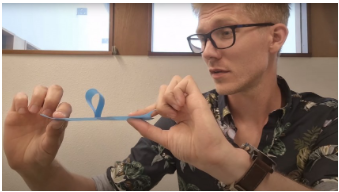
Besides being sticky, what do band aids and adhesive tapes have in common? Blisters and loops of course! Surely, you’ve encountered blisters (tiny air pockets) or loops when using band aids or tapes, which can be quite annoying and difficult to remove. What’s more, they can also affect the materials used to make flexible electronics and soft robotics. Fear not though as researchers from Eindhoven University of Technology and University of Twente have studied the unpeeling of looped adhesive tape and developed a new model to explain how best to remove troublesome loops. The new research is published in European Physics Letters (EPL).
Imagine a tape where the two sticky sides are stuck together resulting in a loop. If you try to remove the loop by pulling the two loop ends, something surprising happens.
Read the full press release through this link
The size of the contact area between the sticky sides starts to decrease but the loop doesn’t then unloop as you might expect. Instead, as you peel the two sides apart, the loop just shrinks in size until it reaches a critical small size and then eventually unloops.
Straight tape loops
Removing loops and blisters has implications for more than just band aids and sticky tape, as Jacco Snoeijer points out. “When working with materials for thin flexible electronics and soft robotics, it’s important to know what forces should be applied to remove blisters or loops. Otherwise, you face the prospect of permanently damaging the material”.
To study how loops change when subject to varying peeling forces and velocities, the researchers decided to study how loops evolved in different tapes. But they needed a reliable way to make straight tape loops in the lab.
“In straight tape loops the two sticky sides of the tape are perfectly aligned or parallel. If the two sides were not parallel, the loop would twist as the size decreased, and we wanted to avoid any twisting physics,” notes Twan Wilting. “As we didn’t have automated devices, we had to make the loops by hand. It goes without saying that it was a testing and trying process!”
Model breakthrough
Once the unpeeling experiments had been complete, the researchers used the observations to construct a new model that describes the loop shrinkage process and gives an indication of the critical loop size (before final unlooping) and the critical peeling force. “The model matches the experimental observations very well. Perhaps in the future we’ll add more to the model, particularly on how the adhesives evolve during unlooping,“ says Snoeijer.
“How to unloop a self-adherent sheet”, Twan Wilting, Martin Essink, Hanneke Gelderblom, and Jacco Snoeijer, European Physics Letters, (2021).
Read also: The miraculous discovery of ‘sticky goo’
Selected for you!
Innovation Origins is the European platform for innovation news. In addition to the many reports from our own editors in 15 European countries, we select the most important press releases from reliable sources. This way you can stay up to date on what is happening in the world of innovation. Are you or do you know an organization that should not be missing from our list of selected sources? Then report to our editorial team.
